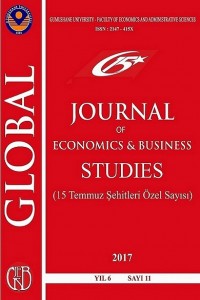FİNANSAL KİRALAMA İŞLEMLERİNİN MEVZUAT BOYUTU VE MUHASEBE UYGULAMALARI: TMS 17 ve VUK KAPSAMINDA İNCELENMESİ
Abstract
Günümüzde şirketler yatırımlarının finansmanı fazladan ek maliyet oluşturduğundan özkaynaklarından veya
banka gibi finans kurumlarından sağlamayıp, alternatif bir finansman yöntemi olarak finansal kiralama yoluna
gitmektedirler. Finansal kiralamanın dünyada kullanımı çok eskiye dayansa da ülkemizde kullanımın yakın bir
geçmişi vardır. Bu kapsamda çalışmanın amacı, finansal kiralama işlemlerinin Vergi Usul Kanunu (VUK),
Türkiye Muhasebe Standardı 17 (TMS 17 Kiralama İşlemleri Standardı) ve Uluslararası Finansal Raporlama
Standardı 16 (UFRS 16 Kiralama Standardı) kapsamında mevzuat boyutuyla ilgili teorik bilgiler vermek ve
örnek uygulamayla finansal kiralama işlemlerinin VUK ve TMS 17’ye göre muhasebe uygulamalarının kiracı
ve kiraya veren açısından benzerlikleri ve farklılıkları tespit etmektir. Çalışmanın sonucunda finansal kiralama
konusu varlıkları kiracının TMS 17’ye göre maddi duran varlıklarda; VUK’a göre ise maddi olmayan duran
varlıklarda gösterilmesi gerektiği tespit edilmiştir. Kiraya veren ise finansal kiralama konusu varlığı TMS 17
ve VUK’a göre 25 Maddi Duran Varlıklarda gösterilmesi gerektiği tespit edilmiştir.
Keywords
References
- Gökgöz, A., (2013), “Finansal Kiralama İşlemlerinin Muhasebeleştirilmesi”, Dumlupınar Üniversitesi Sosyal Bilimler Dergisi, Sayı: 35, ss.108.
- Karadeniz, Salim (2007), “Kiracı Acısından Finansal Kiralama İşlemleri.” Yaklaşım, 169 (2), 39-44
- Mollaoğulları, Batuhan Fatih (2011),Finansal Kiralama İşlemlerinin Tek Düzen Muhasebe Sistemine ve Türk Muhasebe Standartlarına Göre Düzenlemelerinin Uygulamalı Karşılaştırılması, T.C. Celal Bayar Üniversitesi, Sosyal Bilimler Enstitüsü, İşletme Anabilim Dalı, Yayınlanmamış Yüksek Lisans Tezi, Manisa.
- Sarıgül, Suat ve Coşkun Çekiciler (2008), “Finansal Kiralama Tanımı, İşlemlerin Değerlemesi ve Muhasebeleştirilmesi”, Vergi Raporu, 16(111), 127-142.
- Tuğlu, A. ve Atila, Ö., (2007), Finansal Kiralama İşlemleri, Yaklaşım Yayıncılık, ss.25, Ankara.
- Ufuk, Mehmet Tahir (2010), “Finansal Kiralama Sözleşmesinden Doğan Alacakların Değerlemesi”, Yaklaşım Dergisi, 18(206), 91-94.
LEGISLATION AND ACCOUNTING PRACTICES ON FINANCIAL LEASING TRANSACTIONS: INVESTIGATION ON TAS 17 AND VUK
Abstract
Nowadays, companies do not provide funds from their own resources or financial institutions such as banks
because they finance additional investments as an additional cost, and they go to financial leasing as an
alternative financing method. The use of financial leases in the world is very old and there is a close history of
use in our country. The purpose of working in this scope is to provide theoretical information about the financial
aspects of the leasing transactions in terms of the legislative dimension within the scope of the Tax Procedure
Law (Turkish Commercial Code), Turkish Accounting Standard 17 (TMS 17 Leasing Transactions Standard)
and International Financial Reporting Standard 16 (IFRS 16 Leasing Standard) To identify the similarities and
differences between their accounting practices in accordance with VUK and TMS 17 in terms of their
leaseholder and leasehold income. As a result of the work, leasing assets are classified as tangible fixed assets
according to TMS 17; According to the VUK, it has to be shown in intangible assets. The borrower is required
to present the financial leasehold asset in accordance with TMS 17 and 25 Tangible Assets according to VUK.
Keywords
References
- Gökgöz, A., (2013), “Finansal Kiralama İşlemlerinin Muhasebeleştirilmesi”, Dumlupınar Üniversitesi Sosyal Bilimler Dergisi, Sayı: 35, ss.108.
- Karadeniz, Salim (2007), “Kiracı Acısından Finansal Kiralama İşlemleri.” Yaklaşım, 169 (2), 39-44
- Mollaoğulları, Batuhan Fatih (2011),Finansal Kiralama İşlemlerinin Tek Düzen Muhasebe Sistemine ve Türk Muhasebe Standartlarına Göre Düzenlemelerinin Uygulamalı Karşılaştırılması, T.C. Celal Bayar Üniversitesi, Sosyal Bilimler Enstitüsü, İşletme Anabilim Dalı, Yayınlanmamış Yüksek Lisans Tezi, Manisa.
- Sarıgül, Suat ve Coşkun Çekiciler (2008), “Finansal Kiralama Tanımı, İşlemlerin Değerlemesi ve Muhasebeleştirilmesi”, Vergi Raporu, 16(111), 127-142.
- Tuğlu, A. ve Atila, Ö., (2007), Finansal Kiralama İşlemleri, Yaklaşım Yayıncılık, ss.25, Ankara.
- Ufuk, Mehmet Tahir (2010), “Finansal Kiralama Sözleşmesinden Doğan Alacakların Değerlemesi”, Yaklaşım Dergisi, 18(206), 91-94.
Details
| Primary Language | Turkish |
|---|---|
| Journal Section | Articles |
| Authors | |
| Publication Date | July 15, 2017 |
| Published in Issue | Year 2017 Volume: 6 Issue: 11 |

Bu eser Creative Commons Atıf-GayriTicari 4.0 Uluslararası Lisansı ile lisanslanmıştır.


